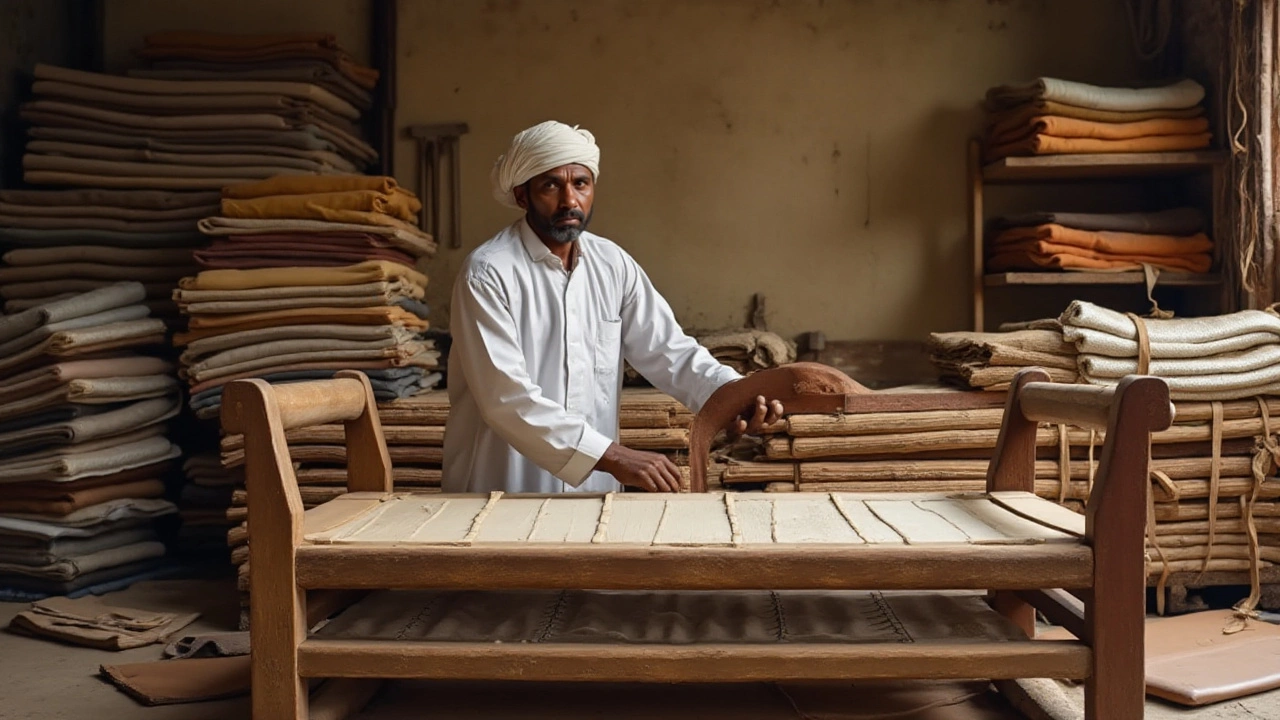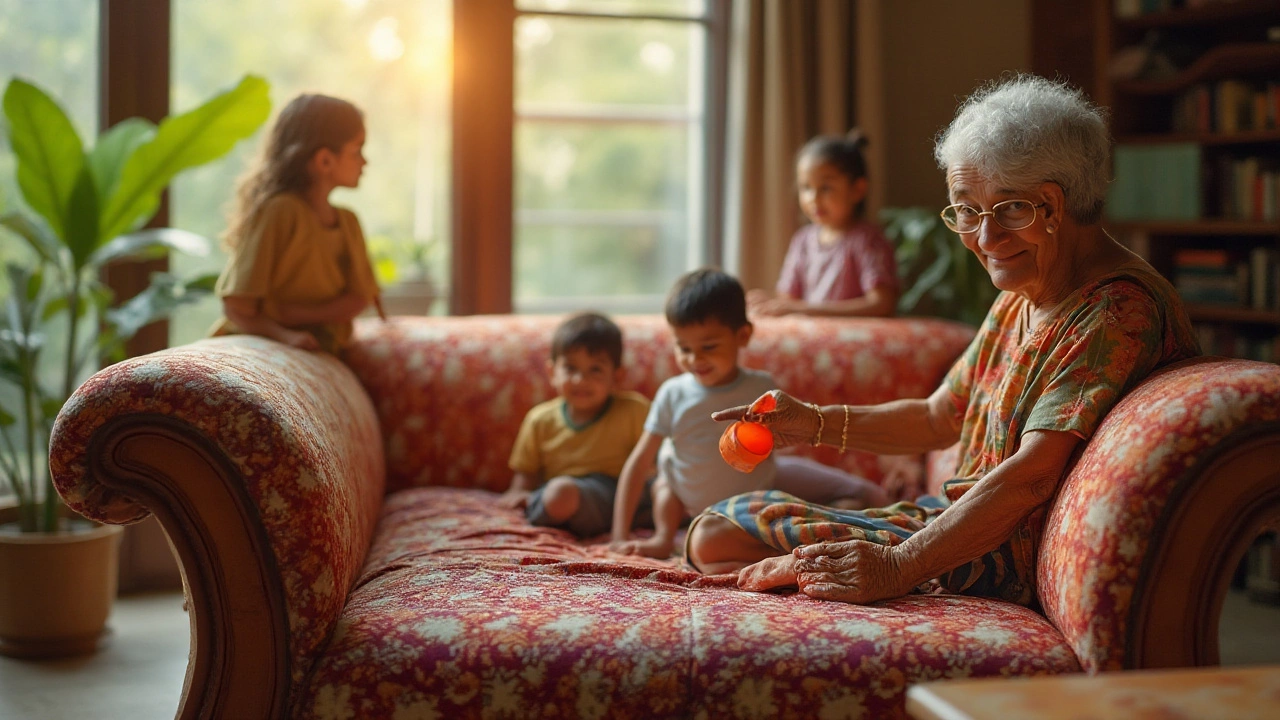A sofa isn't just a piece of furniture; it's an investment in comfort and style for your home. But with so many options available, knowing which sofa will stand the test of time can feel overwhelming. The material from which a sofa is made greatly influences its durability, and understanding different types of upholstery can help you decide wisely.
Leather, for instance, is often celebrated for its durability and elegance. However, high-quality fabric can also offer longevity when woven tightly. It's not just about the material, though—construction matters too. Sofas constructed with robust frames and joined with precision tend to last longer than those hastily put together.
- Importance of Durable Sofas
- Understanding Upholstery Materials
- Construction Techniques for Longevity
- Regular Maintenance Tips
- Choosing the Right Design
- Making an Informed Decision
Importance of Durable Sofas
When selecting the perfect durable sofas, it’s about more than simply finding a comfortable spot to relax. A sofa is often one of the most used pieces of furniture in a household, serving as a space for family gatherings, movie nights, and much-needed afternoon naps. Given its central role in everyday life, a sofa needs to withstand the test of time, both in terms of style and resilience. Investing in a long-lasting sofa ensures it stays in great condition despite daily wear and tear.
One major advantage of choosing a long-lasting sofa is cost efficiency. Replacing an inexpensive sofa with a short lifespan may seem more affordable at first, but purchasing a well-crafted piece provides better value over the years. Today's market offers a variety of sofas, each boasting different qualities of toughness. A higher initial cost may save money in the long run by eliminating the need for frequent replacements. This is especially relevant in homes with children or pets, where additional stress is placed on furniture. Depending on household dynamics, a sofa might need to endure energetic kids or Whiskers the cat’s occasional scratching.
Choosing durable furniture also reduces environmental impact. The production and disposal processes of furniture contribute significantly to carbon footprints worldwide. Opting for a durable sofa means it's less likely to end up in landfill within a few years. This aligns with an increasing public demand for sustainability and environmentally friendly living. In addition, some manufacturers now offer eco-friendly sofas, constructed from renewable materials designed to stand the test of time. In his analysis of sustainable living in 'Eco Chic', eco-designer Danny Seo notes,
"The durability of a product is a significant yet often overlooked aspect of what makes it sustainable.”
Quality sofas also offer enhanced comfort and support. Over time, lower-end couches can sag and lose their shape, providing less support to those using them. A well-built sofa retains its form, offering consistent support and comfort for many years, which is important for anyone suffering from back problems or those who spend a lot of time sitting. Often, it’s a simple yet crucial element that improves the quality of life. While aesthetics play a role in purchasing decisions, never underestimate the significance of comfort!
In terms of aesthetics, choosing a timeless sofa design can keep your living room looking stylish for decades. Classic shapes and neutral colors rarely go out of fashion. Pairing a long-living sofa with updated accessories and decorations can refresh a space without replacement costs. For those who value maintaining a trendy home, investing in a long-lasting sofa that accommodates changing styles is an important consideration. This strategy allows living spaces to evolve around a consistent centerpiece, making furnishing choices more adaptable and personal.
Understanding Upholstery Materials
When it comes to choosing a durable sofa, the upholstery material is perhaps the most vital component to consider. We all desire furniture that not only looks great but also lasts for years. Different materials bring unique benefits and challenges, each influencing the sofa's longevity. Among the top contenders in the world of sofa textiles, leather frequently takes the spotlight. Known for both its durability and classic appeal, leather upholsteries are renowned for withstanding the test of time. Properly treated leather will develop a rich patina and can become softer and more inviting over the years, making it a smart choice for those seeking long-lasting sofas.
Then there's the realm of fabric sofas, which offer a wider range of styles, textures, and colors. High-quality fabrics like microfiber and tightly woven polyester blends are often used for making robust sofas. Microfiber, for example, is admired for its resilience against stains and scratches, making it a favorite among pet owners. However, not all fabrics are created equal. Some may snag or fade faster, especially in high-traffic households, so it's paramount to examine the weave and thread count, often indicated on the product information or tag.
The Spruce furniture editor Kate Reggev once pointed out, "Your choice of upholstery fabric has more influence on the lifespan of your sofa than you might think. It's essential to balance aesthetics with durability."
Another popular choice is velvet, known for its soft texture and luxurious feel. Though traditionally seen as a more delicate fabric, modern advancements have yielded performance velvets designed to resist wear and staining, making them more practical for daily use. If you're someone who appreciates a touch of elegance without compromising on practicality, these performance fabrics might just fit the bill. It's worth mentioning that along with the fabric itself, the dye methods and finish treatments contribute significantly to the fabric's longevity. Pay particular attention to sofas that offer stain-repellent finishes or UV-resistant treatments to minimize fading over time.
Additionally, sustainable options have been gaining traction. Natural fibers like cotton and linen, often blended with synthetic fibers for increased durability, are known for their charm and eco-friendliness. These materials allow your sofa to breathe, which can be particularly beneficial in humid climates. However, they might require more diligent care to keep them looking fresh. Regardless of the material, routine maintenance like vacuuming and spot-cleaning are crucial to preserving your sofa in top condition. For more durable options, pay attention to upholstery with higher Martindale rub test ratings, indicating how much wear the fabric can withstand before showing distress.
In essence, choosing the right upholstery is a balancing act between aesthetics, lifestyle, and the desired level of maintenance. Investigating the different options available can make a world of difference in the longevity of your sofa. Regardless of your final choice, understanding the nuances of upholstery materials empowers you to make an informed decision that aligns with your lifestyle and expectations.

Construction Techniques for Longevity
When it comes to selecting a sofa that will remain part of your life for many years, focusing on its construction is just as important as the material. The frame of the sofa forms its backbone, and the most enduring ones are constructed using solid hardwood. Oak, maple, or beech are examples of woods renowned for their robustness. They provide a sturdy foundation that can withstand years of daily use without warping or breaking easily. Another critical element of sofa construction is the joints that connect the frame. Joints that are glued and dowelled or use screws and corner blocks offer the best lifespan. Avoid sofas that rely solely on staples, nails, or glue, as these methods can't handle substantial weight or constant use.
While examining the sturdiness of a sofa's frame is crucial, don't overlook the importance of the spring system for longevity. Eight-way hand-tied springs are often described as the gold standard. They provide unmatched support and durability, preventing sagging and ensuring optimal comfort over time. While more expensive, this intricate spring system justifies the investment. The alternative, serpentine springs, are often found in more budget-conscious models. When constructed professionally, they can still offer commendable support, as long as they're heavy-duty variations that prevent sagging.
The choice of cushion filling significantly impacts the comfort and longevity of a sofa. High-resilience foam steals the spotlight here, retaining its shape and offering excellent cushioning for many years. While down-filled cushions provide a luxurious level of comfort, they require frequent fluffing and maintenance. Consider a blend of poly-fiber wrapped around a core of high-density foam for the perfect balance of softness and durability.
"Never compromise on the quality of your sofa's construction," says interior designer Jane Doe. "A well-made sofa is an investment in both comfort and lasting value."
Finally, an often overlooked yet vital aspect of sofa longevity is the fabric's integration with the frame. A well-covered sofa won't have taut or sagging fabric. The best sofas feature fabric that is neatly tailored to the edges and corners, without loose threads or puckering. Additionally, check for zippers on cushions. They not only facilitate cleaning but indicate there's been thought and care put into prolonging the sofa's life.
Regular Maintenance Tips
Keeping your durable sofa in pristine condition requires more than just a casual dusting now and then. Regular maintenance is key to ensuring your sofa stands the test of time, mirroring the day your earnest search for long-lasting sofas first began. Start by vacuuming the upholstery weekly to remove crumbs and dust. This simple act can prevent dirt from settling deep into the fabric, which over time can wear down the material. If your sofa has removable covers, make it a habit to wash them according to their care instructions; this not only refreshes the look but also prolongs the lifespan of the fabric.
Preventive care also plays a significant role. Placing your sofa away from direct sunlight prevents fabric and leather from fading or becoming brittle. Consider using a protective cover if your living space is flooded with light, or simply position the sofa away from windows. It’s surprising how minimizing direct exposure can extend the quality of your sofa's materials.
Spills and stains are inevitable, especially in lively households. Addressing them promptly is crucial. Gently blot the affected area with a clean cloth instead of rubbing, which might push the stain deeper. For tougher stains, keeping a fabric cleaner recommended by the sofa manufacturer handy is a smart move. Regularly fluffing cushions and rotating them ensures even wear. This prevents certain spots from sagging or flattening prematurely.
Sofa materials like leather benefit significantly from moisturizers. Applying a leather conditioner every few months can keep the material supple and crack-free. In contrast, fabric sofas often come with tags indicating the type of cleaning agent recommended. Follow these guidelines carefully, as using the wrong product could damage the upholstery. Fabric sofas can also profit from a professional cleaning once a year for a deeper cleanse that household vacuums can’t achieve.
According to furniture expert Jane Doe, "The longevity of a sofa isn't just about the initial cost or material; it’s the consistent care that makes half the battle won." Her insights reflect the importance of regular upkeep, underscoring the role it plays in maintaining a resilient piece of furniture over time.
Having a systemic routine for maintenance can also save you money in the long run. Rather than replacing a sofa every few years due to neglect, a well-maintained piece could last considerably longer, justifying any initial higher costs associated with quality sofa materials. That said, it’s also a good idea to familiarize yourself with the warranty terms. Understanding what is covered and what isn’t can sometimes provide additional peace of mind, knowing that some issues may be resolved without an unexpected financial burden.

Choosing the Right Design
Choosing the right sofa design is more than picking out a pretty piece to fill your living room; it's about understanding your lifestyle and the demands you place on a piece of furniture. A sofa serves both aesthetic and functional purposes, acting as a centerpiece for social gatherings, a resting spot after a long day, or a stage for cozy movie nights. To achieve the right balance, it’s essential to consider how you and your household use the sofa. Do you entertain guests frequently? Or is your home more of a peaceful retreat where you unwind daily? Each answer will guide your design choice.
One significant component of design is size; a gigantic sectional might look appealing on the showroom floor but could dominate a small living room, while a tiny loveseat could feel lost in a spacious great room. Measure your space thoroughly, considering not just the floor area but also the height of the room and proximity to windows. Natural light can fade colors over time, so keep this in mind especially if you're inclined towards vibrant upholstery.
The configuration is another aspect that determines how well a sofa suits a room's dynamic. Traditional sofas offer a classic rectangular shape, ideal for most spaces, while sectionals or modular designs offer more versatility, especially in open-plan homes. "The versatility of modular sofas allows for more creativity in room setups," suggests an article from Architectural Digest.
Style speaks to personal taste, yet it’s important to ensure your sofa fits the greater aesthetic of your home. Modern and minimal designs, with clean lines and neutral tones, can provide a sleek, subtle addition to a contemporary setting. In contrast, a traditional tufted sofa with ornamental legs might suit a home with an old-world charm. Either way, a consistent style echoes throughout the house, creating a harmonious visual ambience.
Color choice also plays into design. A rich navy or a deep forest green might make a statement, adding a touch of drama without overwhelming the room, while lighter hues can maintain a soft, airy feel, creating a sense of openness. Also, consider practicalities; darker shades often mask minor spills or pet fur — something to ponder if you share your home with pets like my own Whiskers or delightful kids.
A table below provides a summary of popular sofa designs and where they best excel:
| Design Type | Best For |
|---|---|
| Sectional | Large spaces, family rooms |
| Chesterfield | Formal settings, classic style |
| Mid-century Modern | Minimalist homes, limited space |
By considering these factors, you'll be able to choose a durable sofa that not only serves your needs but also lasts through the years. The right design isn't just about following trends or sticking to popular choices but genuinely understanding what fits you and your home's narrative. Whether it's an evening ritual with a good book or an occasional nap, choosing the right design is integral to creating a living space that's both functional and inviting.
Making an Informed Decision
Purchasing a new sofa should be an informed and thought-out decision, as it significantly impacts not just the aesthetics of your living room but also its comfort and longevity. One of the first steps in making this choice is understanding the various sofa materials and their durability. Leather, renowned for its timeless elegance and sturdy nature, might be the material of choice for families with children or pets. However, newer advancements in fabric technology have introduced tightly woven synthetics that offer excellent resistance to stains and fading, providing a strong adversary to leather's long-held throne.
What's beneath the surface also matters considerably. The frame is the core of any durable sofa. Hardwood frames, such as those constructed from oak or maple, offer superior resilience compared to softer woods. Kiln-dried wood is particularly favored for its resistance to warping and cracking over time. Take notice of the joinery methods—a sofa constructed with dowels, glue, screws, or brackets typically outlasts those held together by staples or nails alone.
Of course, style is equally important. The design of the sofa should not only fill the space aesthetically but also support regular use. Removable and washable slipcovers can be an ideal choice for high-traffic households, providing an easy way to maintain a fresh look without compromising on durability. A bold choice of color or pattern might reflect current trends, but opting for classic hues means your sofa remains contemporary for years to come. Design flexibility is another asset, with modular sofas providing customizable arrangement options that adapt to changing home dynamics.
It is said, by the famed furniture designer Jean-Michel Frank, "The most beautiful things are often the simplest." This rings true when considering sofas with less ornamentation and fewer intricate parts, which might be vulnerable to wear over time. Minimalist designs often emphasize the quality of materials and construction over elaborate detailing, making them a wise choice for those prioritizing longevity.
"Good design is sustainable design," said Robin Day, a testament to the lasting impact of choosing quality and durability over fleeting trends.
Your decision-making process should also involve practical considerations of space and usage. Measure your room accurately and contemplate the activities that will take place on the sofa. Do you want extra cushioning for movie nights, or a firmer seat for professional meetings? Detachable or reversible cushions can extend the life of your sofa significantly. Also consider the impact of sunlight exposure; prolonged sun can fade certain fabrics, so placement and window treatments might be just as pivotal to longevity as the choice of sofa itself.
Finally, if an extra layer of insight is what you seek, consulting with a retail expert or even reaching out to the manufacturer for detailed specifications can greatly inform your decision. Many retailers offer extended warranties, which not only reflect confidence in their products but also provide a safety net for your investment. Taking the time to examine showroom models, sit on them, and ask questions can also lead to a rewarding purchase experience. Remember, the goal is to find a long-lasting sofa that meets your practical needs and suits your living space, ultimately crafting an inviting atmosphere for all who gather in it.

